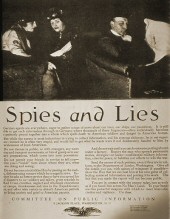Romanticism and pragmatism of social advertising.
(according to CPI documents)
 "The 1917 poster reproduced below, from the photograph published in This Fabulous Century: Sixty Years of American Life, vol. 2, 1910-1920 (New York: Time-Life Books, 1969), p. 234, illustrates the domestic intelligence-gathering efforts of the American government's "Committee on Public Information" during the First World War. Although it would have people believe that German spies were everywhere, this threat was greatly exaggerated. Posters like this encouraged Americans to spy upon one another, to be "vigilant" against those who criticized American involvement in the war. Citizens were urged to inform the Department of Justice if anyone "spreads pessimistic stories ... cries for peace, or belittles our efforts to win the war." The U.S. Congress had passed war-time sedition laws that established heavy penalties for people who criticized the government and its war policies." (link)
"The 1917 poster reproduced below, from the photograph published in This Fabulous Century: Sixty Years of American Life, vol. 2, 1910-1920 (New York: Time-Life Books, 1969), p. 234, illustrates the domestic intelligence-gathering efforts of the American government's "Committee on Public Information" during the First World War. Although it would have people believe that German spies were everywhere, this threat was greatly exaggerated. Posters like this encouraged Americans to spy upon one another, to be "vigilant" against those who criticized American involvement in the war. Citizens were urged to inform the Department of Justice if anyone "spreads pessimistic stories ... cries for peace, or belittles our efforts to win the war." The U.S. Congress had passed war-time sedition laws that established heavy penalties for people who criticized the government and its war policies." (link)
One may draw a conclusion that: advertising is created to induce the consumer to any action e.g. to purchase goods. Founders of
social advertising are not confronted with such problem nor do they have the same motivation as the individuals working in the sphere of commerce. Purpose of Public Service Announcement (PSA): is aimed at changing the attitude of the public inrespect of any problem, and in long-term prospect - to generate new social values for the audience. A subject of social advertising is the idea which should possess certain social values.
Social advertising mentions universal problems (struggle against violence, wildlife management, health of children, AIDS etc.) It is directed at the widest audience. PSA can also reflect interests of narrower groups of the population, for example, the inhabitants of any city worried about cleanliness of water in a local reservoir. The government of the USA began to use PSA even in days of civil war, publishing free announcements of vacancies in the army, about sale of the state bonds, thereby having transformed social advertising into a powerful propagation tool.
When America has entered the First World War, the "Committee on Public Information" explained to the population why the country wages war and that it is necessary to win as well as explaining the population the reason for formation of the committee. In 1942 the Committee was transformed into the Advertising Board which main objective was to "mobilise the nation for a victory". In post-war years Council was engaged in planning of a policy of
social advertising.
Experience of Americans proves that PSA – is an effective remedy of struggle against social harm. Such advertising changes the approach of people to the daily reality and after this their behavior varies too.
 "The 1917 poster reproduced below, from the photograph published in This Fabulous Century: Sixty Years of American Life, vol. 2, 1910-1920 (New York: Time-Life Books, 1969), p. 234, illustrates the domestic intelligence-gathering efforts of the American government's "Committee on Public Information" during the First World War. Although it would have people believe that German spies were everywhere, this threat was greatly exaggerated. Posters like this encouraged Americans to spy upon one another, to be "vigilant" against those who criticized American involvement in the war. Citizens were urged to inform the Department of Justice if anyone "spreads pessimistic stories ... cries for peace, or belittles our efforts to win the war." The U.S. Congress had passed war-time sedition laws that established heavy penalties for people who criticized the government and its war policies." (link)
"The 1917 poster reproduced below, from the photograph published in This Fabulous Century: Sixty Years of American Life, vol. 2, 1910-1920 (New York: Time-Life Books, 1969), p. 234, illustrates the domestic intelligence-gathering efforts of the American government's "Committee on Public Information" during the First World War. Although it would have people believe that German spies were everywhere, this threat was greatly exaggerated. Posters like this encouraged Americans to spy upon one another, to be "vigilant" against those who criticized American involvement in the war. Citizens were urged to inform the Department of Justice if anyone "spreads pessimistic stories ... cries for peace, or belittles our efforts to win the war." The U.S. Congress had passed war-time sedition laws that established heavy penalties for people who criticized the government and its war policies." (link)

1 Comments:
An interesting post, The term PSA is not one that was used back in 1917. Advertising was an important tool of the C.P.I during the Great War. Copy was written by advertising men and the illustrations were created by professional illustrators as well. All of the tools of the commercial advertising industry were put to work to sell the war to the American people.
Post a Comment
<< Home